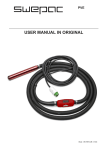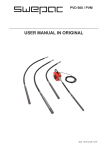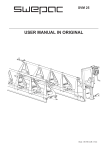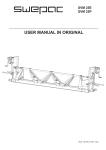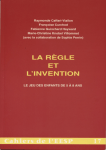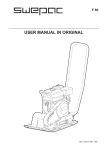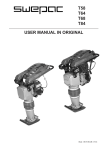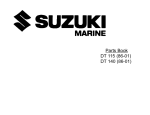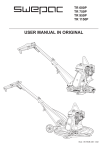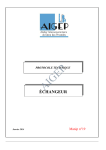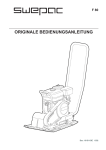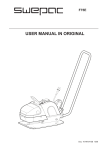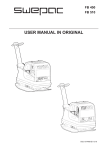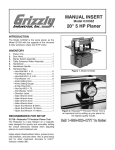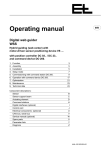Download USER MANUAL IN ORIGINAL
Transcript
PVD 2000 PVS PVM USER MANUAL IN ORIGINAL Dok: 101503-GB 1340 PVD2000 / PVS / PVM CONTENTS SAFETY INSTRUCTIONS...................................... 3 OPERATION, PRECAUTIONS..................3; 4; 5; 6 TRANSPORT, PRECAUTIONS..............................6 TECHNICAL DATA................................................7 HOW IT WORKS................................................7; 8 FIELD OF APPLICATION.....................................9 PREPARATIONS AND OPERATING CONDITION..........................................................10 MAINTENANCE.................................................. .11 PERIODIC MAINTENANCE OF MOTOR......... .11 PERIODIC MAINTENANCE OF FLEXIBLE SHAFT AND POKERS...................... 12 ELECTRIC EQUIPMENT..................................... 12 FAULTY TRACING , DRIVE UNIT..................... 13 FAULTY TRACING , FLEXIBLE SHAFT AND POKERS...................... 13 NOTES...................................................................14 Dok: 101503-GB 1340 EC-DECLARATION OF CONFORMITY.............15 2 PVD2000 / PVS / PVM SAFETY INSTRUCTIONS To reduce the risk of serious injury or death to yourself or others read and understand the Safety and operating instruction before installing, operating, repairing, maintaining, or changing accessories on the machine. Post this Safety and operating instruction at work locations, provide copies to employees, and make sure that everyone reads the Safety and operating instruction before operating or servicing the machine. In addition, the operator or the operator’s employer must assess the specific risks that maybe present as a result of each use of the machine. Additional instructionst for the engine can be found in the manufacturer’s engine manual. Personal precautions and qualifications Only qualified and trained persons may operate or maintain the machine.They must be physically able to handle the bulk, weight, and power of the machine. Always use your common sense and good judgement. Personal protective equipment Always use approved protective equipment. Operators and all other persons in the working area must wear protective equipment,i ncluding at a minimum: • Protective helmet • Hearing protection • Impact resistant eye protection with side protection • Respiratory protection when appropriate • Protective gloves • Proper protective boots • Appropriate work overall or similar clothing (not loose-fitting) that covers your arms and legs. Drugs, alcohol or medication Drugs, alcohol or medication may impair your judgment and powers of concentration. Poor reactions and incorrect assessments can lead to severe accidents or death. Never use the machine when you are tired or under the influence of drugs, alcohol or medication. Dok: 101503-GB 1340 No person who is under the influence of drugs,alcohol or medication may operate the machine. OPERATION, PRECAUTIONS DANGER Explosion hazard If a warm machine or exhaust pipe comes into contact with explosives, an explosion couldoccur. During operating with certain materials, sparks and ignition can occur. Explosions will lead to severe injuries or death. Never operate the machine in any explosive environment. Never use the machine near flammable materials, fumes or dust. Make sure that there are no undetected sources of gas or explosives. Avoid contact with the warm exhaust pipe or the bottom of the machine. DANGER Fire hazard If a fire starts in the machine, it can cause injury. If possible use an ABE-class powder extinguisher, other wise usea BE-type carbon dioxide fire extinguisher. DANGER Fuel hazard The fuel is flammable and fuel fumes can explode when ignited, causing serious injury or death. Protect your skin from contac twith the fuel. If fuel has penetratedtheskin,consult a qualified health professional. Never remove the filler cap,or fill the fueltank when the machine is hot. Fill thef ueltank outdoors or in aclean and well ventilated place, free from sparks and open flames. Fill the fuel tank at least ten meters (30 feet)from the place where the machine is to be used. Release the filler cap slowly to let pressure escape. Never over fill the fuel tank. Make sure the filler cap is screwed on when the machine is used. Avoid spilling fuel on the machine, wipe off any spilled fuel. Check regularly for fuel leaks. Never use the machine if it is leaking fuel. Never use the machine in the proximity of material that can generate sparks.Remove all hot or spark-generating devices before startingthe machine. 3 PVD2000 / PVS / PVM Only store fuel in a container that is specially constructed and approved for the purpose. If the machine has an exhaust, direct the exhaust so as to reduce disturbance of dustin a dust filled environment. Consumed fuel and oil containers must be taken care of and returned to the retailer. Operate and maintain the machine as recommended in the operating and safety instructions. Never use your fingers to check for fluid leaks. Wear washable or disposable protective clothes at the worksite, and shower and change in to clean clothes before leaving the work site to reduce exposure of dust and fumes to your self, other persons, cars, homes, and other areas. WARNING Unexpected movements The machine is exposed to heavy strains during operation.If the machine breaks or gets stuck, there maybe sudden and unexpected movemen that can cause injuries. Always inspect the machine prior to use. Never use the machine if you suspect that it is damaged. Make sure that the handle is clean and free of grease and oil. Keep your feet away from the machine. Never sit on the machine. Never strike or abuse the machine. Pay attention and look at what you are doing. WARNING Dust and fume hazard Dusts and /or fumes generated or dispersed when using the machine may cause serious and permanent respiratory disease, illness, or other bodily injury (forexample, silicosis or other irreversible lung disease that can be fatal, cancer, birth defects, and /or skin inflammation). Some dusts and fumes created by compaction work contain substances known to cause respiratory disease, cancer, birth defects, or other reproductive harm. Dust and fumes in the air can be invisible to the naked eye, so do not rely on eye sight to determine if there is dust or fumes are the air. To reduce the risk of exposure to dust and fumes, do all of the following: Perform site-specific risk assessment. The risk assessment should include dust and fumes created by the use of the machine and the potential for disturbing existing dust. Wear, maintain and correctly use respiratory protection as instructed by your employer and as required by occupational health and safety regulations. Ther espiratory protection must be effective for the type of substance at issue (and if applicable, approved by relevant governmental authority). 4 Work in a well ventilated area. Avoid eating,drinking, and using tobacco products in areas where there is dust or fumes. Wash your hands and face thoroughly as soon as possible upon leaving the exposure area,and always before eating, drinking, using tobacco products,or making contact with other persons. Comply with all applicable laws and regultions, including occupational health and safety regulations. Participate in air monitoring, medical examination programs, and health and safety training programs provided by your employer or trade organizations and in accordance with occupational health and safety regulations and recommendations. Consult with physicians experienced in relevant occupational medicine. Work with your employer and trade organization to reduce dust and fume exposure at the work site and to reduce the risks. Effective health and safety programs, policies and procedures for protecting workers and others against harmful exposure to dust and fumes should be established and mplemented based on advice from health and safety experts. Consult with experts. DANGER Exhaust gas hazard The exhaust gas from the machine’s combustion engine contains carbon monoxide which is poisonous, and chemicals which cause cancer, birth defects, or other reproductive harm. Inhalation of exhaust fumes can cause serious injury, illness, or death. Never inhale exhaust fumes. Ensure good ventilation (extraction of air by fan if necessary). Dok: 101503-GB 1340 Never smoke when filling the fuel tank or when working with the machine or servicing it. PVD2000 / PVS / PVM WARNING Projectiles Failure of the work piece, of accessories, or even of the machine itself may generate high velocity projectiles. During operating, splinters or other particles from the compacted material may become projectiles and cause personal injury by striking the operator or other persons.To reduce these risk: Use approved personal protective equipment and safety helmet, including impact resistant eye protection with side protection. Make sure that no unauthorised persons trespass into the working zone. Keep the work place free from foreign objects. If numbness, persistent recurring discomfort, burning sensation, stiffness, throbbing, tingling, pain, clumsiness, weakened grip,whitening of the skin, or other symptoms occurat any time, when operating the machine or when not operating the machine, stop operating the machine, tell your employer and seek medical attention. Continued use of the machine after the occurrence of any such symptom may increase the risk of symptoms becoming more severe and /or permanent. Operate and maintain the machine as recommended in these instructions, to prevent an unnecessary increase in vibration. WARNING Rotating blades hazards The following may help to reduce exposure to vibration for the operator: There is a risk of hands and feet getting caught by the rotating blades when the machine is running. This can cause personal injury. If the machine has vibration absorbing handles, keep them in a central position, avoid pressing the handles into the end stops. Never place your hands or feet inside the protection ring when the machine is running When the percussion mechanism is activated, the only body contact with the machine yous hould have are your hands on the handle or handles. Avoid any other contact, for example supporting any part of the body against the machine or leaning onto the machine trying to increase the feed force. WARNING Motions hazards When using the machine to perform work-related activities, you may experience discomfort in the hands, arms, shoulders, neck, or other parts of the body. Adopt a comfortable posture whilst maintaining secure footing and avoiding awkward off-balanced postures. Changing posture during extended tasks may help avoid discomfort and fatigue. Make sure that the machine is well-maintained and not worn out. Immediately stop working if the machine suddenly starts to vibrate strongly. Before resuming the work, find and remove the cause of the increased vibrations. In case of persistent or recurring symptoms, consult a qualified health professional. Participate in health surveillance or monitoring, medical exams and training programs offered by your employer and when required by law. WARNING Vibrations hazards When working in cold conditions wear warm clothing and keep hands warm and dry. See the”Noise and vibration declaration statement”for the machine, including the declared vibration values. This information can be found at the end of these Safety and operating instructions. Dok: 101503-GB 1340 Normal and proper use of the machine exposes the operator to vibration.Regular and frequent exposure to vibration may cause, contribute to, or aggravate injury or disorders to the operator’sf ingers, hands, wrists, arms, shoulders and/or nerves and blood supply or other bodyparts, including debilitating and/or permanent injuries or disorders that may develop gradually over periods of weeks, months, or years.Such injuries or disorders may include damage to the blood circulatory system, damage to the nervous system, damage to joints, and possibly damage to other body structures. 5 PVD2000 / PVS / PVM Never grab or touch a rotating machine part. Avoid wearing clothing, neck ware or gloves that may get caught. Cover long hair with a hair net. DANGER Electrical hazard The machine is not electrically insulated. If the machine comes in to contact with electricity, serious injuries or death may result. Never operate the machine near any electric wire or other source of electricity. Make sure that there are no concealed wires or other sources of electricity in the working area. DANGER Concealed object hazard During operating, concealed wires and pipes constitute a danger that can result in serious injury. Check the composition of the material before operating. Watch out for concealed cables and pipes for example electricity, telephone, water, gas, and sewage lines. If the machine seems to have hit a concealed object, switch off the machine immediately. Make sure that there is no danger before continuing. WARNING Involuntary start Involuntary start of the machine may cause injury. Keep your hands away from the start and stop device until you are ready to start the machine. Learn how the machine is switched off in the event of an emergency. WARNING Noise hazard High noise levels can cause permanent and disablinghearing loss and other problems such as tinnitus(ringing, buzzing, whistling, or humming in the ears).To reduce risks and prevent an unnecessary increase in noise levels: Risk assessment of these hazards and implementation of appropriate controls is essential. Operate and maintain the machine as recommended in these instructions. If the machine has as ilencer, check that it is in place and in good working condition. Always use hearing protection. 6 TRANSPORT, PRECAUTIONS WARNING Loading and unloading hazard When the machine is lifted by a crane and similar appliance, this can lead to injury. Use marked lifting points. Make sure that all lifting devices are dimensionedfor the weight of the machine. Never remain under or in the immediate vicinity of the machine. MAINTENANCE, PRECAUTIONS WARNING Unexpected start hazard During maintenance or when changing blades on the machine, there is a risk that the engine backfires or that the machine unexpectedly starts. This applies especially when the engine is hot and if the switch is in position ON.This can result in serious personal injury. Always let the engine cool down. Always turn the switch to position OFF. Always take the cap off the spark plug. WARNING Unexpected start hazard Any machine modification may result in bodily injuries to yourself or others. Never modify the machine. Modified machines are not covered by warranty or product liability. Always use original parts, insertion tools, and accessories. Change damaged parts immediately. Replace worn components in good time. CAUTION High temperature The machine’s engine exhaust pipe, and bottom become hot during operation. Touching them can lead to burns. Never touch a hot machine. Never touch the bottom of the machine when its hot. Wait until the engine, exhaust pipe, and bottom of the machine have cooled down before carrying out maintenance work. STORAGE, PRECAUTIONS Keep the machine in a safe place, out of the reach of children and locked up. Dok: 101503-GB 1340 WARNING Trapping hazards There is a risk of neck ware, hair, gloves, and clothes getting dragged into or caught by rotating machineparts.This may cause choking, scalping, lacerations, or death.To reduce the risk: PVD2000 / PVS / PVM TECHNICAL DATA POWER UNIT PVD 2000 Model type , .....................................................Universal single type Electric Single Phase ........................................Double insulation, IP 34 Housing..............................................................Polyamid Power..................................................................2300 W. Voltage........................ ........................................230V or 115 V 50/60 Hz (Make sure working voltage is according with stated value on the characteristics plate). Loading consummation........................................10 A (220 V) / 20 A (115 V) Unloaded speed........... ..........................................17.000 RPM Loaded speed (Max. shaft length and poker diameter) ...............17.000 RPM Weight......................... ..........................................5.4 KG FLEXIBLE SHAFT AND POKER VIBRATOR HOW IT WORKS: The flexible shaft connected to the drive unit SVM sends transmit the movement to an eccentric weight placed inside the poker head. During the vibration the compaction of the concrete begins. LENGTH (mm) PVM25 PVM32 PVM40 PVM48 PVM58 0,8 1,7 2,2 3,2 4,7 CENTRIFUGUE FORCE (Kg) 90 200 410 550 660 FREQUENCY (V.P.M) 14.000 13.000 13.500 12.500 12.000 CAPACITY (m³/h) UP TO 10 UP TO 12 UP TO 15 UP TO 25 UP TO 35 Dok: 101503-GB 1340 285 367 335 320 360 MODEL WEIGHT (Kg) 7 PVD2000 / PVS / PVM LENGTH (mm) 1,0 2,0 3,0 4,0 MODEL WEIGHT (Kg) PVS 1, alt. PVS 1-32 PVS 2, alt. PVS 2-32 PVS 3, alt. PVS 3-32 PVS 4, alt. PVS 4-32 3,0 4,0 5,0 6,0 The complete poker vibrator assembled includes 3units: Proper protective equipment should be used because the acoustic power level of this machine is 92 dB according to ISO 3744 (85,5 the pressure level ISO 6081) 1Transmited vibration to the operator does not exceed 2,5 m/s2 of acceleration (1,45 m/s2 acc. to ISO 5349 measured value at 1 m of the poker). PVD HOSE* 1m 2m 3m 25 32 40 48 58 1,031 0,694 0,599 1,112 0,764 0,632 1,290 0,868 0,751 1,438 0,968 0,836 1,438 0,968 0,836 Dok: 101503-GB 1340 * Position of holding the hose from the poker Effective value of vibration in HOSE m/s2 Speed of motor 12000 rpm 8 PVD2000 / PVS / PVM FIELD OF APPLICATION AND USE OF CONCRETE VIBRATOR A prerequisite for the finished floor to meet the quality requirements is to properly treat the fresh concrete. During poker vibration, concrete is submitted to vibration which will force trapped air to the surface making concrete homogeneous. It is recommended that the slab be always poker vibrated if the thickness exceeds 100 mm or if the slab is double reinforced. The next step is therefore to thoroughly compact concrete with a poker vibrator. The poker size should be adapted to the density of reinforcement and concrete thickness. Care is required at rails, forms and stop ends. Introduce the vibrator vertically in the concrete mass without moving it horizontally. Do not transport concrete with a poker vibrator. This would increase the risk of over vibration. Always start by leveling vibration. Make short pokes in order to level high spots. The concrete vibrator should be introduced into the mass at regular intervals. The interval should be from approximately 8 times the diameter of the poker. Duration of each insertion shall be inside 5-15 seconds. The time in vibrating the different layers should not be big to avoid cold joints. Do not push or force the vibrator into the mass, it could be stuck in the reinforcements. Always remove the poker vertically with movements upwards and downwards so the concrete fills the empty space again. Do not switch off until you stop the vibration completely. Se speed of removing is approximately 8 cm per second. The time is shorter for a fluid mass; a vibration in excess can produce segregation. It is considered the concrete to be well vibrated when the surface around the poker is shiny and compact and there is no more air bubbles, as well a change in the noise of the vibrator is produced. Keep a distance of 7 cm minimum from any walls or form works. Choose the type of vibrator adequate to the dimensions of the structure to vibrate, the distance among the reinforcement and the slump cone. It is recommendable to have an additional concrete vibrator. Before starting, check that the concrete vibrator is in good condition and it works correctly. Use the means of safety and protection. Pour the concrete in the structure avoiding high heights. Try to pour leveled the concrete. The thickness of every layer should be less than 50 cm, The recommendation is between 30 and 50 cm. In order to vibrate slabs, the poker has to be kept oblique so that the contact superficies with mass is bigger and the compacting effect is better. Do not keep the concrete vibrator out of the concrete during longer periods. Stop it during residence in the concrete vibration. The concrete slab is working as a cooler for the vibrator tub and if this not is respected, a break down will appear inside a shorter period with operating lost and unnecessary cost for the owner. Dok: 101503-GB 1340 Follow the maintenance instructions. 9 PVD2000 / PVS / PVM PREPARATIONS AND OPERATING CONDITION For your own safety, as protection for others, and to avoid damage to the equipment, read carefully this manual and operating guidelines. 1. Before working, be sure that the hose joint sleeve nut is properly fastened to the drive unit. Note! The drive unit must be switched off during this handling and check the correct working of all handling and safety devices. Always use two ways extension cables equipped with two connector plugs in the male and in the female plugs. Male plug is assembled in the motor. Note! Do not use damaged or worn out cables. 2. Screw the poker on the screwed end of the transmission up to fasten with spanner (left threaded). 3. Do not make sharp bends on the flexible shaft during operation 4. Do not over lubricate the inner flexible shaft. 5. Do not keep working the poker out of the concrete more than 5 minutes. 6. Do not restrict the movement of the poker during the work. 7. Do not stop the poker inside the concrete. 8. Change the wear parts to avoid damage to the internal parts. (Check wearing table for the poker) 9. Do the maintenance with the types and quantities of recommended lubricants. 10. Use ear protection according the safety instruction. POKER CONNECTION TO THE FLEXIBLE SHAFT: (POSITION 2 ABOVE). The flexible shafts PVS are intended to connect to the pokers PVM. Dok: 101503-GB 1340 The model PVS 25 due to the diameter need, have a special transmission PVM 1-32, 2-32, 3-32 and 4-32. 10 PVD2000 / PVS / PVM MAINTENANCE ACCEPTED WEAR FOR DIAMETERS AND LENGTHS OF THE POKERS. MODEL SVM 25 SVM 40 SVM 48 SVM 58 DIAMETER (mm) LENGHT (mm) 23,5 (25) 36 (38) 45,5 (48) 55,5 (58) 310 (220) 330 (335) 355 (360) 360 (365) A. The minimum dimensions are bold printed. B. The dimensions into brackets are the original dimensions. C. Replace the housing when reach the minimum diameter. D. Replace the end cap when reach the minimum length. Note! Always use SWEPAC original parts PERIODIC MAINTENANCE OF MOTOR (Inside the drive unit) 1. Only an expert shall work on the electrical part. 2. Make sure that the electricity is off during repairs. 3. In all maintenance operations, original parts will be used. 4. A periodic lubrication of the converters’ bearings is not necessary. 5. Every 100 hours carbon brushes should be inspected .They should be changed if effective length is less than 5 mm. 6. Clean the ventilation vents in the front and back part of the motor periodically to avoid overheating. 7. Check that the filter is situated in the air intake, under the switch. If it is soiled, change it. To do this, just pull the old filter downwards and introduce a new one in the same position that the old one was. 8. After maintenance and service works, all safety devices should be assembled correctly. 9. Every 12 months or more frequently, depending on the usage conditions, it’s recommended an inspection be done by an authorized dealer. Dok: 101503-GB 1340 10. Clean the filter often or replace it if necessary. 11 PVD2000 / PVS / PVM PERIODIC MAINTENANCE OF FLEXIBLE SHAFT AND POKERS 1. To do the maintenance works in the transmission and poker, firstly disconnect of the motor. 2. In all maintenance operations, original parts will be used. 3. To check the wear of the poker controlling the outside diameter and length of the poker. Replace the housing or cap when the diameter or length in the least point is less than the specified in the table according to the model. 4. Lubricate the shaft every 100 working hours. The recommended quantity is 25 g per meter. Do not over lubricate, it could cause the grease penetrate into the poker; Do not clean the shaft with solvent. The grease recommended is STABURAGS N-4 of the brand KLÜBER 5. When the length of the shaft is not equal to the hose (+-10 mm) it is necessary to repair before producing a bigger breakdown. 6. Every 300 hours of working is recommended to change the lubricant of the poker. 7. To do a maintenance follow the following steps: - Flush the parts with solvent and wipe all part. - Examine bearings, seals and hex driver. If inspection reveals that grease of transmission has penetrated into the head, the oil seals need replacement. When replacing seals, mount them back to back (neoprene seal lips face away from each other). - The purpose of the seals is to keep the oil of the head in, and the flexible shaft grease out. Be careful not to damage the polished surface where the seal goes. When the seals are dismounted it is recommended to change it. - Fill the cavity of the cap with a light oil non-foaming SAE40 or equivalent. - Apply sealant before assembling and fix the O ring. Tighten and clean the excess sealant. It is important all the parts are tightened to avoid water and cement try to get into the head. 8. After maintenance job and service, all the parts must be assembled correctly. 9. Every 12 months or more frequently, depending on the usage conditions. It is recommended an inspection be done by an authorized dealer. ELECTRIC EQUIPMENT PVD2000 ELECTRIC WIRINGS AND ELECTRIC COMPONENTS NOTE: All cables should be properly adapted to the housing provided in the housing before closing the two cover parts. Dok: 101503-GB 1340 1. PLUG 2. SWITCH CABLE. 1.5 mm2 3. SWITCH CABLE. 1.5 mm2 4. EARTH CABLE (GREEN-YELLOW) 5. CAPACITOR 6. SWITCH 7. MOTOR-SWITCH CABLE 1.5 mm2 8. MOTOR-SWITCH CABLE 1.5 mm2 9. WINDING FIELDS 10. CONNECTION TO BRUSHES 12 PVD2000 / PVS / PVM FAULTY TRACING, DRIVE UNIT PROBLEM CAUSE / SOLUTION The drive unit is not starting 1. Make sure power is on 2. Carbon brushes defect 3. Defective switch The motor rotate but it overheats 1. Clean the air intake and output openings in the housing and/or change filter. 2. Make sure nuts and bolts fixing outer box are properly fixed 1. Verify voltage of electrical system 2. Check the cable specification 3. Defective poker or shaft 1. Defective carbon brushes 2. Defective bearings 3. The rotor might be touching the stator 4. Outer cladding broken or has loose bolts The motor works slow and overheats The motor becomes too noisy FAULTY TRACING, FLEXIBLE SHAFT AND POKER PROBLEM CAUSE / SOLUTION 1. Head is over lubricated with oil 2. To much or to less grease in the shaft 3. Failure on the seal, the transmission grease have escaped to the tube, or the opposite. The oil has escaped to the shaft 4. Head movement is restricted. 5. The flexible shaft is extreme bent 6. Transmission shaft is in bad condition Bearing failure 1. Not enough with oil in the tube 2. The vibrator tube has been working to long outside the concrete slab. 3. Water has penetrated into the tube Dok: 101503-GB 1340 The motor works with overload and become overheated 13 PVD2000 / PVS / PVM Dok: 101503-GB 1340 NOTES 14 PVD2000 / PVS / PVM EC-declaration of conformity Manufacturer Swepac AB Blockvägen 3 34132 Ljungby 1. Category: PokerVibrator 2. Type: PVD2000 PVS PVM The product complies with the following directives: 2006 / 42 / EG 2000 / 14 /EG 2004 / 108 / EG EN 500-1 EN 500-4 EN 12649:2008+A1:2011 ISO 11201 ISO 5349-2:2001 Technical documentation held by: Dok: 101503-GB 1340 Swepac AB, Blockvägen 3 SE-34132 Ljungby Hans Holmlund / Product Manager 15 SWEPAC AB Address Blockvägen 3, 341 32 Ljungby, Sweden, tel. +46 (0)372-156 00, fax +46 (0)372-837 41, E-mail [email protected], Internet www.swepac.se



















